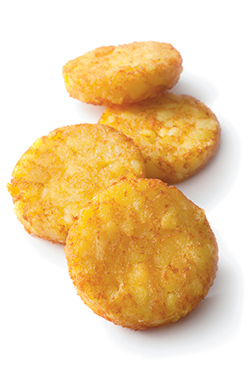Countertop griddles are typically categorized as heavy-duty countertop cooking equipment and are versatile workhorses that have a central location in many kitchen equipment lineups.
 Foodservice operators can use this equipment, powered by either gas or electricity, to crisp and brown, sear, warm or toast menu items throughout the day. The most popular foods cooked on griddles are breakfast fare, such as pancakes and eggs, in addition to proteins, sandwiches and vegetables.
Foodservice operators can use this equipment, powered by either gas or electricity, to crisp and brown, sear, warm or toast menu items throughout the day. The most popular foods cooked on griddles are breakfast fare, such as pancakes and eggs, in addition to proteins, sandwiches and vegetables.
Griddle plates usually measure between 24 and 72 inches wide and 24 or 30 inches deep. These units typically come with adjustable legs that offer the ability to modify the working height. Typically, griddle plates are 1/2-, 3/4-, 5/8- or 1-inch thick.
The standard countertop griddle design has a metal plate heated by either gas burners or electric elements from underneath, with controls normally found on the front of the equipment. Each burner is spaced 8 to 12 inches apart and can be individually controlled. A splashguard is usually located on both sides and attached to the rear. There also is a grease trough to capture grease and debris in a holding tray that is most often found in the front.
Although electric models are available, gas griddles are more common since these are less costly. Infrared gas units are pricier but provide superior heat transfer to more of the griddle plate surface. This type reduces gas usage by 12 percent to 20 percent, with faster recovery, consistent cook times and greater throughput.
Countertop griddle plate thickness impacts both price and performance. The higher the volume, the thicker griddle plate needed to maintain consistent
surface temperatures.
Steel is the most common plate material and the most economical. This type is durable but tends to emit more heat into the kitchen and is not as aesthetically pleasing as other materials. It also requires special cleaning solutions to maintain. Chrome plates are durable with proper use and emit the least amount of heat into the kitchen. These plates limit food flavor transfer and food sticking. Although this type is often used in display kitchens due to a more high-end appearance, special tools and cleaners are required for maintenance. Composite plates provide five times the heat transfer of steel plates and have the fastest recovery times. This durable material also limits food flavor transfer and food sticking. Composite materials emit less heat than steel, are the easiest to clean and are proprietary to some manufacturers. End users may also choose to fully groove or partially groove the griddle plate to achieve markings on food products.
When it comes to griddle controls, the majority are straight flow control valves, and 30 percent to 40 percent are thermostats. Manual types are the most economical. With this type, there are no temperature measurements, as the height of the flame is adjusted directly. Modulating thermostatic controls are less expensive but offer less control than the snap-action and solid-state type and cannot be calibrated as effectively. Snap-action controls are mechanically or electronically controlled, while the electronically controlled solid-state type provides high efficiency with a thermocouple to sense the temperature of the plate. Digital/cooking computer controls are the most high-end and costly. These are electronically controlled and may be programmed with temperatures and times for use with various food types.
Additional options include a welded plate divider to prevent flavor transfer and under-device plumbing.










